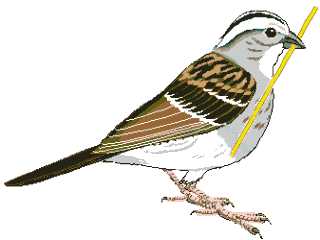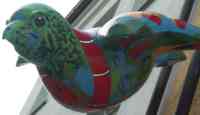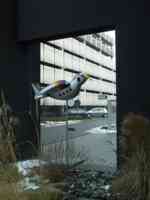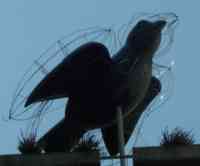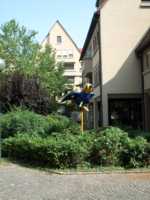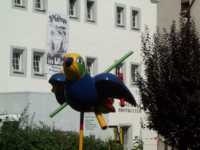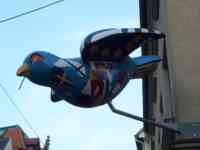The Münster
The pride of Ulm is the Münster. This cathedral boasts the highest church
steeple in the world, 161.5 meters. It dominates the town and symbolized
Ulm's independence, prestige, and wealth.
Construction began three hours after sunrise on June 30, 1377, and finished
on May 31, 1890.
|
The Sparrow
The sparrow (Der Spatz) is Ulm's mascot. In the late 1800s, the city
adopted a fictional story of a sparrow helping build the Münster when
workers confronted wooden beams loaded crosswise on carriages. The beams
were too long to fit through the narrow city gate. The story says the
workers were inspired when a sparrow turned a straw sideways to get it into
its nest. While the story does not reflect well on the workers, it stands
for the sparrow's cleverness. In spite of the late origin of the legend,
the sparrow has been associated with Ulm since at least 1573.
As early as 1530, a bird sculpture perched on the roof of the Münster and
was probably there since 1471. It was later reinterpreted as a sparrow and
was replaced around 1840 with a sandstone sparrow sculpture, an unusual
decoration for a cathedral. The sandstone sculpture was replaced at least
once by another and was finally replaced by a gold-plated copper sparrow in
1889.
The sparrow appears throughout Ulm, as a team mascot, as cute sculptures
and carvings, on coffee mugs and postcards, and molded in chocolate.
|
Franco-Prussian War
Tensions between France and Prussia culminated in the Franco-Prussian War.
A crisis arose when France opposed a German candidate for the Spanish
throne. German reports of the negotiations provoked France, which declared
war on July 19, 1870.
Over the course of the war and its aftermath, the French empire became a
republic, the loose union of German states became an empire, French
Alsace-Lorraine became German Elsaß-Lothringen, and Italy seized the Papal
States from France.
After the Siege of Paris, an armistice was signed on January 28, 1871, and
the Treaty of Frankfurt ended the war on May 10, 1871.
France was forced to pay reparations, which included stone for the Münster.
The Savonnieres limestone the French delivered was too soft and had to be
replaced 123 years after the southern choir tower was finished.
The city of Ulm, the state of Baden-Württemberg, and the German federal
government paid for most of the renovations, but the rest had to be
financed by private contributions and activities.
|
Giant Sparrow Fundraising
 |
| Spatzeninvasion poster. |
To raise some of the money, the 1889 sculpture was scanned in three
dimensions, and 255 enlarged reproductions were molded from plastic. The
giant sparrow is 1.35 meters high and 1.80 meters long with a wingspan of
1.2 meters, four times that of the original.
Sponsors put up about $1100 for each sparrow—about $800 for
manufacture and the rest as a donation. Sparrows were decorated by artists,
high-school and college students, sick children, decorator teams from
retail shops, and employees of large companies.
Decorated sparrows were auctioned off or kept by their sponsors. Auction
proceeds were split between the sponsor, the artist(s), and the Cathedral
Construction Association. About $145,000 was raised.
In the summer of 2001, the sparrows were displayed around Ulm. Several
dozen remain on public display.
The Spatzeninvasion poster displays all 255 sparrows.
|
